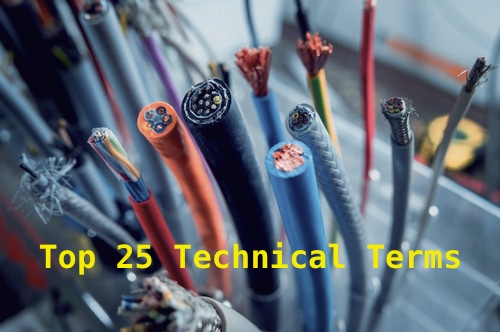Electrician training is hands-on work, but it also requires some academic and book knowledge. To prepare for your electrician education, it’s a great idea to get a head start on learning the important terms electricians need to use on the job. This list will get you started with 25 important electrical terms.

The number of jobs for electricians is growing every day and getting into this line of work is a smart move. All you need to get on the path to becoming a professional electrician is the right education. As you get ready to start an electrician training program, you’re probably eager to learn your new trade right now. If you haven’t started your program yet, you can get started by learning some of the more common technical terms that electricians use regularly.
By learning some of these terms now, you’ll make a good impression on your instructors and let them know you are serious about electrical trade school. Getting a head start may also erase some of the anxiety you may feel over starting something new. Being prepared now means you will be ready to go on day one of classes.
Basic Electrical Circuit Terms
Starting with the basics, electrician training means you will be learning all about electric circuits. A circuit is a path that a current of electrons flows through. Here are some of the related terms you’ll want to know.
- Alternating Current (AC). This is a type of current that reverses direction with a regular pattern, usually several times per second.
- Direct Current (DC). A direct current is a current that only flows in one direction through a circuit. You won’t work much with DC current in electrical trade schools, as most modern circuits are AC.
- A fuse is a device that is used to interrupt the current in a circuit for reasons of safety. When the current in the circuit gets too high, a strip of wire in the fuse melts and breaks the circuit. The fuse has to be replaced to get current going through the circuit again.
- Also referred to as the Earth, the ground is a reference point. Voltage is measured with respect to the ground. The term also refers to the return path that electric current takes. When a circuit is grounded it protects people from dangerous levels of current and voltage.
- In electrician training, you will work with many loads. A load is anything that uses up electrical energy. Lights, motors, and transformers are just a few examples.
- A circuit that has become overloaded is dangerous. Overload refers to the use of equipment in a circuit that exceeds its capacity and creates more current than the circuit can handle safely. Eventually, an overload will lead to overheating and damage to the circuit and components.
- Parallel Circuit. In a parallel circuit, current can flow through multiple, parallel paths. Full voltage goes to each load connected in the circuit.
- Series Circuit. In a series circuit, there is only one path for electrical current. With loads connected in series, the amount of voltage through each one is different.
- Short Circuit. A short circuit is a fault in a circuit that causes current to take a different path. This sometimes causes damage, but certainly wastes energy and is usually caused by poor insulation of the circuit.

Electrician Training Tools
When you start your classes in trade school, electrician tools will be important for hands-on learning. It helps to know what some of these are before the first day, so you won’t feel lost.
- An ammeter is a tool that measures the amount of current in a circuit. With a traditional ammeter, current is measured by placing the ammeter in series in a circuit, which necessarily interrupts the circuit. A clamp-on style ammeter can be used without disrupting the circuit.
- A conductor is anything that will allow electrical current to flow through it. Metals are materials that conduct well and are considered conductors, which is why circuits are made of metal wires. Aluminum and copper are most commonly used.
- Digital Multimeter. Your most useful tool in electrician training will be the all-purpose multimeter. This is a tool that can do it all: measure current, capacitance, resistance, voltage, frequency, and temperature.
- A generator changes mechanical energy into electrical energy. They come in many different forms, but basically generators run nearly all power grids by providing the electrical energy we all use.
- An insulator is the opposite of a conductor. It resists the flow of current. In electrical work it is used to protect circuits, to keep the current contained within the circuit, and to protect people from electric shocks.
- This is a device made of a coil of conductive metal wire. When current is sent through the coil it becomes magnetic.
Electrical Units and Measurements
Electrician training comes with math and calculations, but they are mostly simple. It becomes especially easy to understand the math behind electrical work and circuits when you understand the measurements and units.
- Current and Amperes. Current is the flow of electrons through a circuit and the amount of current in a circuit is measured in units of amperes, or amps for short. This is why the tool for measuring current is called an ammeter.
- Capacitance and Farads. A capacitor is something you will use often in electrical trade school. It is a circuit element that holds electrical charge and capacitance is a measurement of how much charge it can hold. This is measured in units called farads.
- Power and Watts. Another measurement you will learn about in electrician training is power. Electrical power is a measurement of how fast electrical energy can be transferred through a circuit. The basic unit for measuring power is the watt, but kilowatt is used more often.
- Resistance and Ohms. Different materials resist electrical current to varying degrees and resistance is a measurement of that. Insulators have higher resistances than conductors. An ohm is the basic unit of measurement for resistance.
- Voltage and Volts. Voltage is a force or pressure that makes electrons move through a circuit to produce a current. A volt is the basic unit of measurement.

Working with Conduits in Electrician Training
The electrical conduit is the tube that protects the wiring of a circuit. Working as an electrician you will have to use conduit often, manipulating it, shaping, it and measuring it to make sure it adequately fits the circuit you are installing or fixing.
- Hand Bender. Conduit is often made of metal and needs to be bent to fit a space. A hand blender is a tool used to bend a piece of conduit by hand. This tool comes in different sizes to match the job as needed.
- Four Bend Saddle. In electrician training, you will also learn to create a four bend saddle, a four-way bend in conduit to avoid obstacles and to fit the conduit to a particular space.
- Working with conduit and manipulating it to fit a space means doing some calculations. Gain refers to how much extra distance you get out of conduit by not bending it, by taking a straight path instead. This has to be calculated to get the right fit.
- This is the term used for the actual bends that are put in the conduit. Getting around an obstacle typically includes two offsets in the conduit, the first bend to go around it and the second to get back on the original path.
- When bending conduit around obstacles, you naturally lose some of the length of the conduit. The amount by which a piece of conduit is lessened because a bend is called the shrink.
Electrician training is an exciting educational experience. Learning terms like these are just the beginning. Once you get into your electrical trade school, you will start to put this knowledge to use by getting hands-on experience with circuits, tools, measurements, conduit bending, and more. Before you know it, you’ll be building circuits, wiring rooms, troubleshooting electrical problems.
Your electrician training begins with getting enrolled at Florida Technical College’s electrical diploma program. Most people learn to become an electrician by going through an electrician trade school before finding a position. At FTC you get hands-on learning with experienced instructors who have actually worked in the field. The program will teach you everything you need to start out as an entry-level or apprentice electrician and also will prepare you to pass the NCCT exams needed for those positions.
In addition to providing you with a great electrical education, FTC makes starting your new career convenient. You get a class schedule that works with your lifestyle, so you can keep working or taking care of your family while you learn. Contact the electrical diploma program today to get started on the path to an exciting new life as an electrician.



